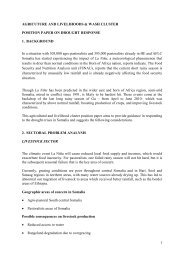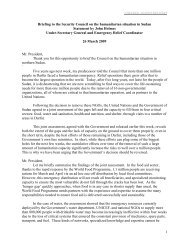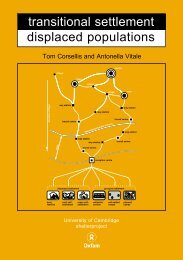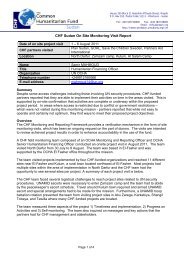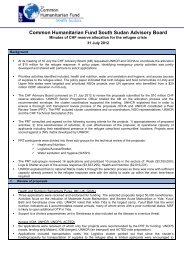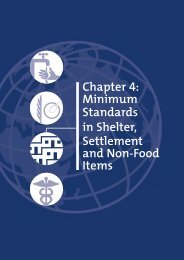Inter-Agency Real Time Evaluation of the Humanitarian ... - OCHANet
Inter-Agency Real Time Evaluation of the Humanitarian ... - OCHANet
Inter-Agency Real Time Evaluation of the Humanitarian ... - OCHANet
Create successful ePaper yourself
Turn your PDF publications into a flip-book with our unique Google optimized e-Paper software.
2 ‐ Context<br />
Magnitude <strong>of</strong> <strong>the</strong> disaster:<br />
IA RTE <strong>of</strong> <strong>the</strong> humanitarian response to Pakistan’s 2010 Floods crisis<br />
1. Pakistan’s 2010 floods are considered amongst one <strong>of</strong> <strong>the</strong> major disasters <strong>of</strong> <strong>the</strong> 21 st<br />
century due to <strong>the</strong> disaster’s widespread geographical scale and distribution (from <strong>the</strong><br />
Himalayan Plateau to <strong>the</strong> Arabian Sea), <strong>the</strong> unprecedented caseload <strong>of</strong> affected population<br />
andits economic impact. In fact, it was <strong>the</strong> largest disaster ever recorded in terms <strong>of</strong> affected<br />
area, affected people and households damaged. Comparatively, in total, a wider area and more<br />
people have been affected by <strong>the</strong>se floods than those affected by <strong>the</strong> Indian Ocean Tsunami<br />
that swept across 14 countries in 2004, <strong>the</strong> Pakistan 2005 and <strong>the</strong> Haiti 2010 earthquakes<br />
combined.<br />
2. According to <strong>the</strong> Pakistan’s National Disaster Management Authority (NDMA), <strong>the</strong> 2010<br />
floods constitute <strong>the</strong> country’s largest disaster 1 as some 20,202,327 persons, approximately 10%<br />
<strong>of</strong> <strong>the</strong> country’s population, was affected, despite <strong>the</strong> scale <strong>of</strong> <strong>the</strong> disaster, casualties remained<br />
relatively low at 1,985. However, <strong>the</strong> number <strong>of</strong> casualties was relatively low in comparison to<br />
o<strong>the</strong>r recent disasters such as <strong>the</strong> 2005 Kashmir earthquake (casualty ratio 1:100). However, it<br />
must be noted that <strong>the</strong> 2005 earthquake, while deadlier was more localized 2 .<br />
3. The 2010 Pakistan floods began in late July, and following heavy monsoon rains that<br />
lasted for more than eight weeks, <strong>the</strong>y evolved from normal flash floods into a massive disaster<br />
affecting large parts <strong>of</strong> <strong>the</strong> countryThe floodwater waves washed down from north to south as<br />
<strong>the</strong> Indus River caudal extended to about forty times its usual size and at one point, submerged<br />
a fifth <strong>of</strong> <strong>the</strong> country’s land mass. Initially, <strong>the</strong> provinces <strong>of</strong> Balochistan and Khyber<br />
Pakhtunkhwa (KPK) were flooded. In mid August, as flood waters flowed south and as Punjab<br />
and Sindh provinces experienced resultant widespread flooding, entire populations residing on<br />
both sides <strong>of</strong> <strong>the</strong> Indus River basin were affected. The floods directly and/or indirectly affected<br />
78 <strong>of</strong> Pakistan’s 121 districts, devastating and submerging entire villages, roads, bridges, water<br />
supply and sanitation infrastructure, agricultural lands, livestock as well as washing away houses<br />
and health and education facilities.<br />
1<br />
IRIN PAKISTAN: Top 10 natural disasters since 1935. It is <strong>the</strong> fifth flood in Pakistan affecting 5 million or more in less<br />
than 40 years.<br />
2<br />
Link to comparative graph: http://ndma.gov.pk/Documents/flood_2010/flood_comparison.pdf<br />
Riccardo Polastro, Aatika Nagrah, Nicolai Steen and Farwa Zafar<br />
17




